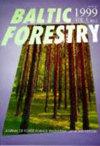Patterns of fungal diversity in needles, rootlets and soil of endemic Macedonian pine, Pinus peuce
IF 0.6
4区 农林科学
Q3 FORESTRY
引用次数: 0
Abstract
Pinus peuce is a five-needle pine native to high-elevation montane habitats of the Balkans. This study aimed to assess the diversity and composition of fungal communities associated with soil, rootlets and living needles of P. peuce at three high-altitude forest sites with different edaphic conditions and stand characteristics in south-eastern Montenegro. In total, 90 samples of each substrate (needles, rootlets and soil) were sampled. DNA amplification using ITS2 rDNA as a marker and high-throughput sequencing resulted in 23,394 high-quality reads, representing 825 fungal taxa. There were 52.5% Basidiomycota, 43.9% Ascomycota and 3.6% Mucoromycotina. There were 118 unique fungal taxa in the rootlets, 230 in soil and 113 in the needles, and only 8 taxa were shared. The most common fungi in rootlets were Rhizopogon mohelensis (11.0%), Suillus americanus (8.4%), and R. fallax (6.9%), in soil – Phlebiopsis gigantea (5.1%), Tylospora asterophora (2.9%), and Sollicocossima terricola (2.7%), and in the needles – Dothideomycetes sp. (17.6%), Dothideomycetes sp. (10.7%), and Leotiomycetes sp. (6.5%). The results showed that functional tissues and the rhizosphere soil of P. peuce were inhabited by a high diversity of fungi. Fungal communities in the rootlets and soil were largely determined by the site conditions such as soil properties and forest stand composition. Keywords: Pinus peuce, five needle pine, high-altitude forests, ectomycorrhiza, pathogens, saprotrophs, Montenegro马其顿松(Pinus peuce)针叶、细根和土壤中真菌多样性的模式
松柏是一种五针松,原产于巴尔干半岛的高海拔山区。本研究旨在评估黑山东南部3个不同土壤条件和林分特征的高海拔森林样地杉木(P. peuce)土壤、根茎和活针真菌群落的多样性和组成。每种基质(针、根和土壤)共取样90份。使用ITS2 rDNA作为标记进行DNA扩增和高通量测序,得到23,394个高质量reads,代表825个真菌分类群。担子菌属占52.5%,子囊菌属占43.9%,毛菌属占3.6%。根系中有118个独特的真菌类群,土壤中有230个,针叶中有113个,共有8个。根系中最常见的真菌是莫helrhizopogon(11.0%)、美洲水蛭(8.4%)和黄毛霉(6.9%),土壤中最常见的真菌是巨斑菌(5.1%)、asterophortylospora(2.9%)和陆生Sollicocossima(2.7%),针叶中最常见的真菌是Dothideomycetes sp.(17.6%)、Dothideomycetes sp.(10.7%)和Leotiomycetes sp.(6.5%)。结果表明,白杨的功能组织和根际土壤中存在着高度多样性的真菌。根系和土壤中的真菌群落在很大程度上取决于立地条件,如土壤性质和林分组成。关键词:杉松,五针松,高海拔森林,外生菌根,病原菌,腐养菌,黑山
本文章由计算机程序翻译,如有差异,请以英文原文为准。
求助全文
约1分钟内获得全文
求助全文
来源期刊

Baltic Forestry
农林科学-林学
CiteScore
1.60
自引率
0.00%
发文量
23
审稿时长
>12 weeks
期刊介绍:
The journal welcomes the original articles as well as short reports, review papers on forestry and forest science throughout the Baltic Sea region and elsewhere in the area of boreal and temperate forests. The Baltic Sea region is rather unique through its intrinsic environment and distinguished geographical and social conditions. A temperate climate, transitional and continental, has influenced formation of the mixed coniferous and deciduous stands of high productivity and biological diversity. The forest science has been affected by the ideas from both the East and West.
In 1995, Forest Research Institutes and Universities from Estonia, Latvia and Lithuania
joined their efforts to publish BALTIC FORESTRY.
 求助内容:
求助内容: 应助结果提醒方式:
应助结果提醒方式:


